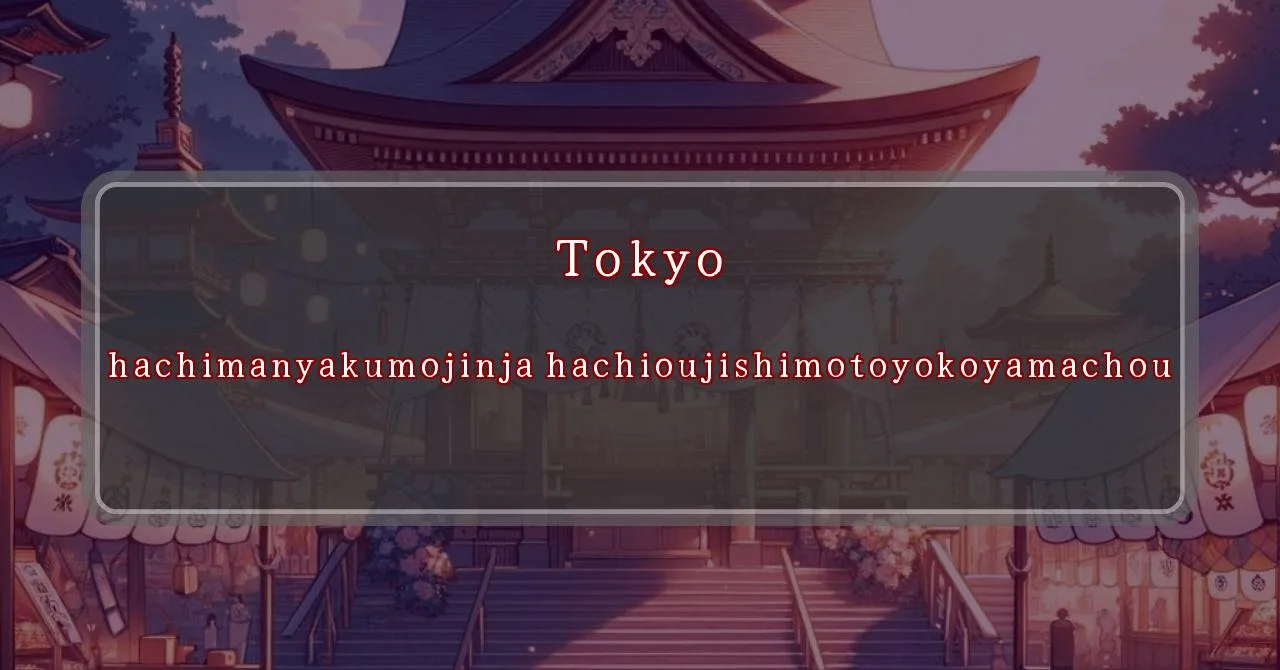Gleaming lights, divine spirits, and ancient traditions await.
Basic Information
Hachiman Yakumo Shrine is a Shinto shrine located in Moto-Yokoyamacho, Hachioji City, Tokyo, Japan. It is dedicated to the deities Hachiman and Susanoo-no-Mikoto.
- Address: 2-15-27 Moto-Yokoyamacho, Hachioji-shi, Tokyo 192-0063
- Phone Number: 042-623-0720
- Access: 10-minute walk from JR Hachioji Station North Exit, or 2-minute walk from Yokoyamacho 3-chome bus stop via Keio Bus from JR Hachioji Station North Exit
- Festival Days: September 15th (Sun), 2024 (Reiwa 6)
Main Events and Attractions of the Festival
The Hachiman Yakumo Shrine Festival is a vibrant and colorful event that attracts many visitors each year. The main events and attractions of the festival include:
Mikoshi Procession
The mikoshi procession is a highlight of the festival. A mikoshi is a portable shrine that is carried through the streets by a group of people. The Hachiman Yakumo Shrine mikoshi is particularly large and impressive, and it is carried by a team of over 100 people.
Kagura Performance
Kagura is a traditional Japanese performing art that combines music, dance, and storytelling. During the Hachiman Yakumo Shrine Festival, kagura performances are held several times a day. These performances are a great way to learn about Japanese culture and history.
Bon Odori Dance
Bon odori is a traditional Japanese folk dance that is performed during the Obon festival, which is a time to honor the spirits of the dead. During the Hachiman Yakumo Shrine Festival, bon odori dances are held in the evening. Visitors are welcome to join in the dancing, and it is a great way to experience Japanese culture firsthand.
Food and Games
The festival also features a variety of food and games. Visitors can enjoy traditional Japanese dishes such as yakitori, takoyaki, and okonomiyaki. There are also a variety of games to play, such as ring toss and goldfish scooping.
Fireworks Display
The festival concludes with a spectacular fireworks display. The fireworks are launched from a nearby hill, and they light up the night sky with their vibrant colors. The fireworks display is a fitting end to a day of celebration.
Blessings and Deities
Hachiman Yakumo Shrine is dedicated to two deities: Hachiman and Susanoo-no-Mikoto. Hachiman is the god of war and archery, and is also revered as the protector of the nation. Susanoo-no-Mikoto is the god of the sea and storms, and is also known for his role in slaying the eight-headed serpent, Yamata no Orochi.
- Hachiman: God of war and archery, protector of the nation
- Susanoo-no-Mikoto: God of the sea and storms, slayer of Yamata no Orochi
Origin and History
The origins of Hachiman Yakumo Shrine are unclear, but it is believed to have been founded in the 9th century. The shrine was originally dedicated to Hachiman, but Susanoo-no-Mikoto was added as a deity in the 13th century. The shrine has been rebuilt several times over the centuries, and the current buildings date from the 17th century.
- Founded: 9th century
- Original deity: Hachiman
- Susanoo-no-Mikoto added as a deity: 13th century
- Current buildings: 17th century
Tips and Notes for Visitors
Here are some tips and notes for visitors to Hachiman Yakumo Shrine:
- The shrine is open daily from 9:00 AM to 5:00 PM.
- Admission is free.
- The shrine is a popular tourist destination, so it is best to visit during the off-season (November-February) to avoid crowds.
- The shrine is located in a residential area, so please be respectful of the neighbors.
- There is a small parking lot available for visitors.
Parking Information
There is a small parking lot available for visitors to Hachiman Yakumo Shrine. The parking lot is located behind the shrine, and it can accommodate about 20 cars. The parking fee is 500 yen per day.
Popular Stalls and Food Carts in Recent Years
| Type of Stall | Description |
|---|---|
| Takoyaki | A staple at Japanese festivals. Characterized by a crispy outside and a creamy inside. |
| Jaga Butter | A simple yet popular snack of hot potatoes lavishly topped with melted butter. |
| Baby Castella | Small castella cakes, sweet and fluffy treats enjoyed by children and adults alike. |
| Grilled Ayu with Salt | Fresh ayu fish grilled whole with salt, a savory taste of Japanese summer. |
| Shaapin | A unique gourmet item influenced by foreign cuisine, with a chewy skin wrapping the filling. |
| Okonomiyaki | A Japanese grilled dish where you often choose your own ingredients for a personalized flavor. |
| Cotton Candy | A fluffy, sweet snack that’s extremely popular with children. |
| Chocolate Banana | A banana coated in chocolate, a fun and visually appealing dessert. |
| Kushiyaki | Various types of ingredients skewered and grilled, an easy-to-enjoy snack. |
| Yakisoba | Fried noodles mixed with a special sauce, a fast food favorite in Japan. |



